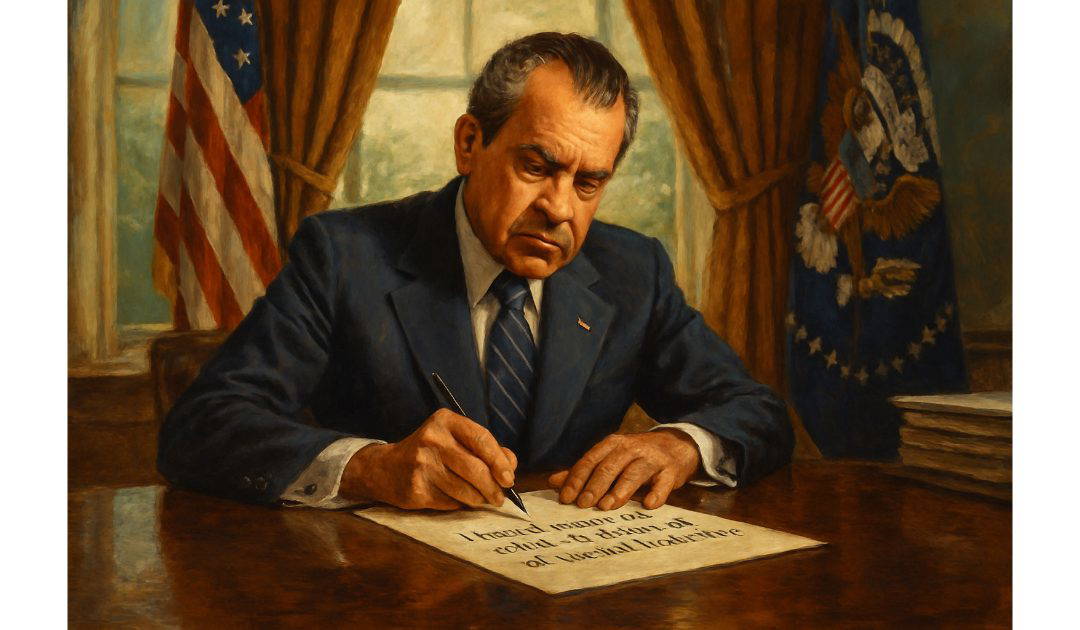On the 9th of August, 1974, Richard Nixon resigned as President of the United States as a direct result of the Watergate scandal.
Origins of the Scandal
The roots of the Watergate scandal trace back to the Nixon administration’s attempts to secure re-election in 1972. On the 17th of June , 1972, five men were arrested for breaking into the Democratic National Committee (DNC) headquarters at the Watergate complex in Washington, D.C. They were caught attempting to wiretap phones and steal documents. Initially, this incident seemed like a simple burglary, but thorough investigations revealed connections to Nixon’s re-election campaign, known as the Committee to Re-elect the President (CRP), often mockingly referred to as “CREEP.”
Unraveling the Cover-up
The Nixon administration quickly attempted to cover up its involvement. High-ranking officials orchestrated schemes to hinder the FBI’s investigation, providing hush money to the burglars and instructing the CIA to intervene in the FBI’s probe, falsely citing national security concerns.
Despite these efforts, investigative journalists Bob Woodward and Carl Bernstein of The Washington Post pursued the story relentlessly. Their reporting, aided by an anonymous government source known as “Deep Throat” (later revealed to be FBI Associate Director Mark Felt), uncovered a trail leading directly to the White House.
Senate Hearings and Revelations
Growing public pressure led to the formation of a Senate committee to investigate the Watergate affair in 1973. Televised hearings captured the nation’s attention, revealing the extent of the administration’s misconduct. A pivotal moment came when former presidential aide Alexander Butterfield disclosed the existence of a secret taping system in the Oval Office, which had recorded many of Nixon’s conversations.
Special Prosecutor Archibald Cox, appointed to lead the investigation, demanded access to these tapes. Nixon refused, citing executive privilege, leading to a constitutional crisis. This standoff culminated in the “Saturday Night Massacre” on the 20th of October 20, 1973, when Nixon ordered the firing of Cox. Both the Attorney General and his deputy resigned in protest before the Solicitor General finally carried out the order. This event triggered widespread outrage and accelerated the investigation.
The Tapes and the “Smoking Gun”
After a protracted legal battle, the Supreme Court unanimously ruled in United States v. Nixon that the president must release the tapes. When finally disclosed, the recordings contained irrefutable evidence of Nixon’s involvement in the cover-up. The most damaging tape, known as the “smoking gun,” revealed Nixon discussing plans to obstruct the FBI’s investigation just days after the break-in.
Resignation and Aftermath
Facing imminent impeachment with bipartisan support, Nixon announced his resignation on the 8th of August, 1974, effective the next day. Vice President Gerald Ford assumed the presidency and later granted Nixon a full pardon for any crimes he might have committed while in office, a controversial decision intended to help the nation move forward.
The Watergate scandal had profound and lasting effects on American politics. It led to a surge in cynicism and scepticism towards government officials. In response, Congress enacted reforms designed to increase transparency and limit executive power, including the War Powers Act and amendments to the Freedom of Information Act.
Moreover, the scandal underscored the critical role of a free press in holding those in power accountable. The diligent work of investigative journalists like Woodward and Bernstein became a hallmark of journalistic integrity and courage.
Legacy of Watergate
Decades later, the term “-gate” has become synonymous with political scandals worldwide. However, the Watergate affair remains unique due to its direct connection to the highest office in the United States and its demonstration of how democratic institutions can function to check abuses of power.
In essence, Watergate was not just a story of political corruption but also a testament to the resilience of democratic principles. It highlighted the importance of checks and balances, the rule of law, and the enduring strength of civic institutions in the face of challenges to democratic norms. Feels rather topical, don’t you think?

